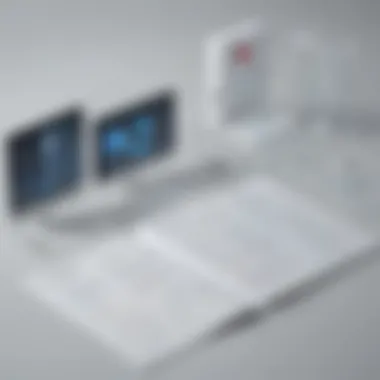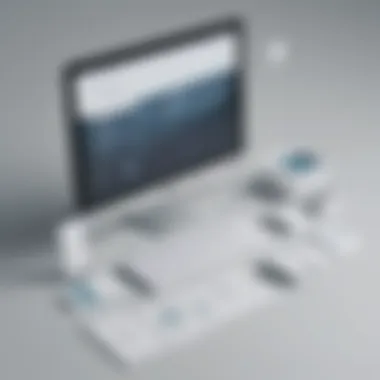Unveiling the Wealth of Remote Nursing Courses: An Exhaustive Guide


Tech Trend Analysis
In the realm of nursing education, a notable trend that has been gaining momentum in recent years involves the integration of remote learning opportunities. This advancement in educational technology has revolutionized the way aspiring nurses can access and acquire knowledge and skills. By leveraging online platforms and virtual resources, institutions are now offering remote nursing courses, allowing students to engage with course materials and instructors from any location with internet connectivity.
This trend holds significant implications for consumers within the nursing field. Remote nursing courses provide unparalleled flexibility, enabling individuals to pursue education while juggling other commitments such as work or family responsibilities. Additionally, remote learning eliminates geographical barriers, allowing students from diverse backgrounds to access quality nursing education without the need to relocate or commute to a physical campus. As the demand for skilled healthcare professionals continues to grow, remote nursing courses present a promising avenue for individuals looking to enter or advance in the nursing profession.
Looking towards the future, the possibilities for remote nursing education are vast. With ongoing advancements in educational technology and digital learning platforms, we can anticipate increasingly interactive and immersive learning experiences for nursing students. Integration of virtual reality simulations, personalized learning pathways, and real-time feedback mechanisms may soon become standard features in remote nursing courses, enhancing the quality and effectiveness of online education in the healthcare domain.
Introduction
Remote nursing courses have quickly become a vital component of modern healthcare education. This comprehensive guide delves deep into the realm of remote nursing courses, shedding light on their significance, benefits, and available options for aspiring nurses. As the landscape of nursing education continues to evolve, understanding the shift towards remote learning in nursing is crucial for both current professionals and those embarking on their nursing journey. This section aims to elucidate the importance of exploring remote nursing courses in fostering a well-rounded understanding of the field.
Understanding the Shift to Remote Nursing Education
The transition to remote nursing education signifies a paradigm shift in how future healthcare professionals are trained. With advancements in technology and the need for flexible learning options, remote nursing courses offer students the chance to access quality education from anywhere in the world. This section will delve into the nuances of this shift, highlighting the benefits and challenges it presents to both educators and learners.
Significance of Remote Nursing Courses
Remote nursing courses play a crucial role in democratizing access to quality education in the healthcare sector. By offering flexible learning options, diverse resources, and opportunities for career advancement, these courses cater to the evolving needs of aspiring nurses. This segment will explore the key benefits of remote nursing courses and their impact on shaping the future of nursing education.
Overview of the Article
This article serves as a comprehensive guide for individuals interested in remote nursing courses. From discussing the emergence of remote learning in nursing to exploring top courses available, each section is curated to provide a detailed understanding of the subject matter. By presenting a structured overview of the content to follow, readers can navigate through the nuances of remote nursing education more effectively, gaining insights that are essential for making informed decisions regarding their academic and professional pursuits.
Benefits of Pursuing Remote Nursing Courses
Remote nursing courses have significantly transformed the landscape of nursing education in recent years. In this article, we delve into the various advantages and considerations associated with opting for remote nursing courses. By embracing remote learning, nursing professionals can expand their knowledge and skills while adapting to the evolving healthcare environment. Remote nursing courses offer a flexible learning approach that accommodates busy schedules and diverse learning styles. This flexibility enables students to balance their academic pursuits with other commitments, making education more accessible and convenient. Moreover, remote nursing courses provide students with the opportunity to access a wide range of educational resources from anywhere in the world, breaking down geographical barriers and promoting inclusivity in education. With the advancement of technology, remote nursing courses offer cutting-edge resources and tools that enhance the learning experience and prepare students for real-world challenges in the healthcare industry.
Flexibility in Learning


The concept of flexibility in learning within the realm of remote nursing courses is paramount. It allows students to personalize their learning experience, Tailor (individualize) and customize their program according to their unique needs and preferences, ensuring optimal engagement and knowledge retention. Flexibility in learning encourages self-paced learning, enabling students to study at their own convenience and manage their study hours effectively.Usage (enables individuals) to accommodate personal and professional commitments. This adaptability is particularly beneficial for working professionals who aspire to advance their nursing careers without interrupting their current job responsibilities. Moreover, flexibility in learning foster (promotes) a collaborative virtual learning environment where students can actively engage with peers and instructors in discussions, group projects, organization seminars, and knowledge-sharing activities, enhancing their overall learning experience.
Accessibility to Diverse Educational Resources
One of the key advantages (benefits) of pursuing remote nursing courses is the accessibility to diverse educational resources. Through remote learning platforms, students have access to a plethora (wide varietydiversity) of learning materials such as e-books, video lectures, online journals, and virtual libraries, to deepen their understanding of complex nursing concepts and stay updated with (remain abreast of) the latest industry trends and research. This accessibility to diverse educational resources encourages students to explore (engage with) a wide array of topics within the nursing discipline, broaden their knowledge base, and cultivate a holistic perspective on healthcare delivery. Additionally, accessing diverse educational resources fosters self-directed learning and empowers students to take charge of their academic journey, promoting critical thinking, inquiry-based learning, and lifelong learning skills.
Opportunities for Career Advancement
Remote nursing courses not only offer academic enrichment but also present ample opportunities for ca professional growth and career advancement. By acquiring advanced knowledge and specialized skills through remote learning programs, nurses can enhance (boost) their career prospects, expand their employment opportunities, and qualify for leadership positions in various healthcare settings. Additionally, remote nursing courses equip nurses with the expertiseNe specialization needed to excel in specialized areas of nursing, such as telehealth, informaticsTech services (information technologysystems), nursing education, and research. These specialized skills open doors to diverse career paths within the healthcare industryf sector, both nationally and internationally, allowing nurses to explore new horizons
Top Remote Nursing Courses
In this article, we will delve into the realm of top remote nursing courses to provide a detailed understanding of their importance in the field of nursing education. By focusing on specific elements, benefits, and considerations about these top remote nursing courses, we aim to equip aspiring nurses with valuable insights and opportunities for learning and growth.
Virtual Learning Environments in Nursing Education
Exploring the aspect of Comprehensive Study of Online Teaching Strategies within virtual learning environments offers a unique perspective on educating future nurses remotely. This segment contributes significantly to the overall goal of enhancing nursing education through digital platforms. The key characteristic of Comprehensive Study of Online Teaching Strategies lies in its ability to bridge the gap between theory and practice effectively in virtual settings. Its benefit as a popular choice for this article is evident in its capacity to engage students actively and promote interactive learning experiences. However, a potential disadvantage may be the challenge of monitoring individual progress closely in an online setting.
Utilizing Simulation Technologies in Virtual Nursing Labs
The integration of Simulation Technologies in Virtual Nursing Labs revolutionizes how practical skills are developed in remote nursing courses. This aspect plays a crucial role in providing hands-on experience in a digital environment, enhancing students' proficiency in clinical procedures. The key characteristic of using simulation technologies is its ability to mimic real-life scenarios, allowing students to apply theoretical knowledge effectively. Its popularity in remote nursing education is due to the realistic learning opportunities it offers, aiding in better skill acquisition. Despite its advantages, a drawback of this approach may be the lack of physical patient interaction, which is essential in traditional clinical settings.
Telehealth and Remote Patient Care
When delving into the Fundamentals of Telemedicine and Telehealth, we uncover a pivotal aspect of remote nursing courses pertaining to healthcare delivery at a distance. This topic significantly contributes to the overarching goal of optimizing patient care remotely through technological advancements. The key characteristic of understanding telemedicine and telehealth lies in its emphasis on leveraging digital platforms for medical consultations and monitoring. Its popularity stems from the convenience and accessibility it provides to both patients and healthcare providers. However, a potential disadvantage could be the challenges in ensuring the secure exchange of sensitive patient information.
Managing Patient Care Remotely
Managing Patient Care Remotely is another crucial aspect that ensures the effective delivery of healthcare services from a distance. This element is instrumental in promoting patient safety and continuity of care through telecommunication platforms. The key characteristic of this practice is its focus on remote assessment, diagnosis, and treatment planning, enabling healthcare professionals to address patient needs virtually. Its popularity in this article stems from its ability to reach geographically isolated populations and enhance healthcare access. Nevertheless, a challenge could be maintaining the same level of patient-provider relationship established in traditional face-to-face interactions.


Remote Health Monitoring and Data Analysis
Discussing the potential of Utilizing Wearable Technology for Health Monitoring sheds light on the progressive nature of remote healthcare services. This aspect contributes significantly to the advancement of patient care by enabling continuous health data tracking through wearable devices. The key characteristic of wearable technology lies in its ability to provide real-time health metrics, empowering individuals to actively monitor their well-being. Its popularity in this context lies in the convenience and personalized insights it offers to both patients and healthcare providers. Nonetheless, a potential disadvantage may be the accuracy and reliability of data obtained from these devices.
Analyzing Remote Data for Patient Diagnostics
The segment focusing on Analyzing Remote Data for Patient Diagnostics underscores the importance of leveraging digital information for enhancing diagnostic processes in remote healthcare settings. This aspect contributes to the overall goal of using data analytics for precision medicine and personalized patient care. The key characteristic of data analysis is its capacity to identify trends and patterns in health data, leading to more accurate diagnosis and treatment decisions. Its popularity in this article stems from its potential to revolutionize diagnostic practices and improve patient outcomes. However, a challenge may lie in ensuring the security and privacy of patient data throughout the analysis process.
Ethical Considerations in Remote Nursing Practice
Exploring the nuances of Understanding Privacy and Confidentiality in Remote Care reveals essential ethical considerations that guide nursing practice in virtual settings. This aspect plays a critical role in maintaining patient trust and upholding confidentiality standards in remote healthcare interactions. The key characteristic of privacy and confidentiality awareness is its emphasis on safeguarding sensitive patient information and respecting individual rights to data privacy. Its importance in this article is evident in fostering ethical decision-making and trust between healthcare providers and patients. Nevertheless, a challenge could be balancing information security measures with the seamless delivery of healthcare services.
Ethical Decision-Making in Virtual Healthcare Settings
Lastly, delving into Ethical Decision-Making in Virtual Healthcare Settings provides insights into the complex ethical dilemmas that healthcare professionals may encounter in remote practice. This aspect contributes to the broader goal of promoting ethical conduct and professionalism in virtual healthcare environments. The key characteristic of ethical decision-making is its focus on moral reasoning and principles when facing challenging situations in remote patient care. Its significance in this article lies in nurturing a culture of ethical awareness and responsibility among nursing professionals. However, a challenge may arise in applying universal ethical standards across diverse cultural and social contexts within remote healthcare settings.
Factors to Consider Before Enrolling in a Remote Nursing Course
Accreditation and Program Credibility
When embarking on a journey towards remote nursing education, one of the paramount considerations is ensuring that the chosen program holds reputable accreditation and maintains high program credibility. Accreditation assures students that the curriculum meets established standards of quality and rigor essential for a comprehensive education. An accredited program not only enhances the credibility of the qualification obtained but also ensures that graduates meet the industry's demands and expectations. Prospective students should meticulously research the accreditation status of the remote nursing course to guarantee a robust educational experience that is recognized within the healthcare sector.
Technology Requirements for Remote Learning
The technological landscape plays a pivotal role in remote nursing education, underscoring the necessity for students to possess the right tools and proficiency to engage effectively with the online learning environment. Understanding the technology requirements for remote learning involves evaluating one's access to reliable internet connections, compatible devices for virtual classes, and proficiency in using online platforms for coursework and collaboration. By meeting these essential technological prerequisites, students can optimize their learning experience, ensuring seamless participation in lectures, discussions, and virtual clinical simulations.
Clinical Placement Opportunities
One of the defining aspects of a comprehensive nursing education is the practical application of theoretical knowledge in real-world clinical settings. For aspiring remote nursing students, securing adequate clinical placement opportunities remains a crucial consideration in honing their practical skills and competencies. While pursuing a remote nursing course, individuals must explore potential avenues for clinical placements, ensuring they have access to supervised hands-on experiences that complement their online learning. By prioritizing clinical placement opportunities, students can bridge the gap between theoretical learning and practical application, preparing themselves effectively for a successful nursing career in virtual healthcare settings.


Challenges and Solutions in Remote Nursing Education
Remote nursing education presents unique challenges that require innovative solutions to ensure effective learning outcomes. In this section, we will delve deep into the critical importance of addressing these challenges and exploring viable solutions to enhance the remote nursing education experience.
Overcoming Connectivity Issues for Seamless Learning (250- words)
Connectivity issues can impede the seamless delivery of remote nursing education, disrupting lectures, discussions, and practical sessions. Reliable internet connectivity is paramount for students to access course materials, participate in virtual classes, and engage with instructors and peers. Addressing connectivity challenges involves investing in robust infrastructure, such as high-speed internet services and technical support systems.
Additionally, educators can optimize learning platforms for low-bandwidth connections, utilize offline access features, and provide alternative communication channels to ensure continuous engagement. Emphasizing the importance of contingency plans for connectivity failures and offering technical assistance round-the-clock can prevent disruptions and maintain a smooth learning experience for remote nursing students.
Enhancing Interaction and Collaboration in Virtual Settings (250- words)
Fostering interaction and collaboration in virtual settings is essential for creating an engaging and enriching learning environment. To overcome the limitations of physical separation, educators can leverage technology tools like virtual whiteboards, discussion forums, and video conferencing platforms to facilitate active participation and communication.
Encouraging group projects, case studies, and interactive simulations can promote peer-to-peer collaboration and critical thinking skills among remote nursing students. Implementing structured breakout sessions, virtual clinical scenarios, and online study groups can replicate the teamwork and interdisciplinary interactions experienced in traditional nursing education settings.
Ensuring Practical Skills Development through Remote Instruction (250- words)
Developing practical skills is fundamental to nursing education, encompassing hands-on training, clinical rotations, and simulation exercises. In the context of remote instruction, maintaining the quality of practical skills development poses a significant challenge.
To overcome this hurdle, educators can utilize virtual reality simulators, 3D anatomy models, and remote monitoring technologies to enhance hands-on learning experiences. Introducing tele-mentoring programs, where students interact with experienced practitioners in real-time, can provide valuable clinical insights and guidance.
Furthermore, establishing partnerships with healthcare facilities for virtual clinical placements and incorporating skill validation assessments via teleconferencing can ensure that remote nursing students acquire and refine essential practical competencies.
Conclusion
As we wrap up this comprehensive guide on exploring remote nursing courses, it becomes clear that the landscape of nursing education is evolving rapidly, and embracing remote learning is paramount for future success in the field. The topic of the conclusion delves deep into summarizing the key insights regarding remote nursing education and its implications on the future of healthcare. Understanding the essence of transitioning to remote nursing courses, aspiring nurses can navigate the challenges and opportunities that come with this educational shift. Through this segment, we aim to provide a lens through which individuals can gain a holistic view of the remote nursing education ecosystem, preparing them to make informed decisions for their academic and professional journeys.
Embracing the Future of Nursing Education
Looking towards the horizon of nursing education, the embracement of remote learning stands as a pivotal milestone in revolutionizing the way nurses are trained and prepared for the dynamic healthcare landscape. As technology continues to shape the healthcare industry, the integration of remote nursing courses becomes not just a choice but a necessity. Embracing the future of nursing education entails recognizing the power of virtual learning environments, telehealth advancements, and ethical considerations in remote nursing practice. By acknowledging these shifts, nurses can equip themselves with the knowledge and skills needed to thrive in a digital healthcare era. The future of nursing education is deeply intertwined with remote learning, paving the way for innovative practices and improved patient care outcomes.
Final Thoughts on Remote Nursing Courses
In culmination, remote nursing courses present a transformative opportunity for individuals passionate about healthcare to expand their knowledge and expertise beyond traditional boundaries. The importance of remote nursing courses lies in their ability to democratize education, making quality training accessible to a diverse range of aspiring nurses worldwide. As we reflect on the significance of remote nursing courses, it becomes evident that they not only offer flexibility and convenience but also serve as a catalyst for professional growth and career advancement. By engaging with remote nursing education, individuals can unlock a world of possibilities, contributing to the enhancement of healthcare services and the betterment of patient wellbeing on a global scale.



